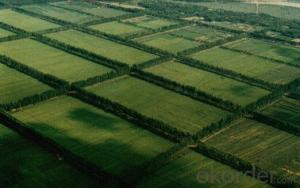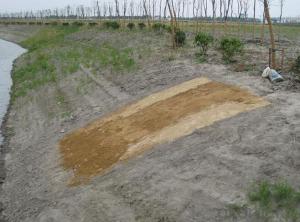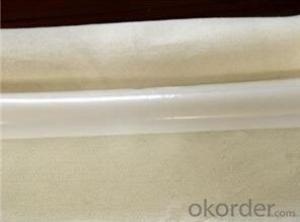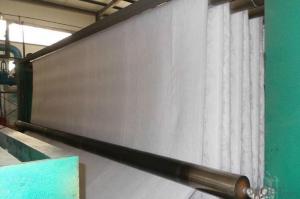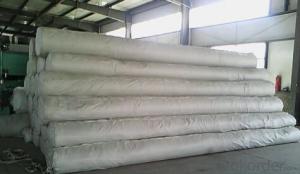Non-Woven Polyester and Polypropylene Nutrition Geotextile
- Loading Port:
- Qingdao
- Payment Terms:
- TT OR LC
- Min Order Qty:
- 5000 m²
- Supply Capability:
- 2000000 m²/month
OKorder Service Pledge
OKorder Financial Service
You Might Also Like
Nutrition geotextile in water environmental engineering .
Specification:
Geotextile has excellent permeability, acquired, durability, which can be widely used in railway ,highway, movement hall,Dams,hydraulic structures hence hole, coastal shoal, reclamation,environmental protection and other projects. The main products are Synthetic staple fibers needle punched nonwoven geotextiles and split film yarn woven geotextiles.
Product Feature:
1. Simple and fast construction
2. Achieve the greening effect quickly after construction
3. Due to the grass and composite fiber fabrics become into one integration, so it has the ability of certain degree of flow resistance for the water rising before the grass survive.
4. Composite fiber fabric is a continuous structure from slope top to slope toe, both ends are fixed, has high water flow resistance.
Technical Specification
5.0 m length and 1.05 m width. Reverse side all used filter material. Grass seeds: Bermuda grass (warm season grass), Bahia grass (warm season grass), Kentucky bluegrass (cold season grass), Tall fescue grass (cold season grass), Red fescue grass (cold season grass). Plant height: 0.1 ~ 0.5 m.
| NO. | Items | Specification | Notes | |||
| 1 | Total unit area weight g/sq.m | ≥380 | ||||
| 2 | dimension | width m | 1.0~2.0 | |||
| length m | as per user’s request | |||||
| 3 | Composite fiber fabrics | Material | Polyester Fiber | High strength PET | ||
| Unit area weight g/sq.m | ≥160 | |||||
| Mesh dimension mm | 8×8 | |||||
| Extension strengh kn/m | ≥11 | MD & CD | ||||
| 4 | Filtra layer | Material | Polyester non woven geotextile | |||
| Unit area weight g/sq.m | ≥40 | |||||
| 5 | Grass seeds, Fertilizer | Type | According to actual situation choose 3~5 grass seeds | |||
| Plant height m | 0.1~0.3 | |||||
| 6 | Fiber layer | Material | wood pulp cellulose | |||
| Unit areaweight g/sq.m | ≥15 | |||||
| 7 | flow resistance | ≥4 | not allow appear scour, suction and blanket turn-over etc. damage phenomenon | |||
| M/s | ||||||
| 8 | Anti-UV strengh conservation rate % | 65~80 | 3000hrs Continuously exposure 3000hrs | |||
| 9 | Supporting spare parts | ABS fastening nail | Material | ABS Resin | Fixed between two blankets by length direction | |
| Fiber diameter mm | 35 | |||||
| Nail length mm | 325 | |||||
| Lnail | Material | Steel wire (content 10% zinc-aluminium alloy) | Used to fix single blanket | |||
| Fiber diameter mm | 4 | |||||
| Nail length mm | 200 | |||||
| ABS connecting nail | Material | ABS Resin | Used in the slope between the two blankets ( width direction) | |||
| Nail length mm | 38 | |||||
| Connecting fiber | Material | High strength Polypropylene | Used in the slope between the two blankets ( width direction) | |||
| Length mm | Cut as per request | |||||
APPLICATION:
Generally laid on the river channel, slope protection etc. slope revetment projects, to control the water erosion, soil loss, meantime can reach the effect of slope ecological restoration and landscape greening, making river back to natural.
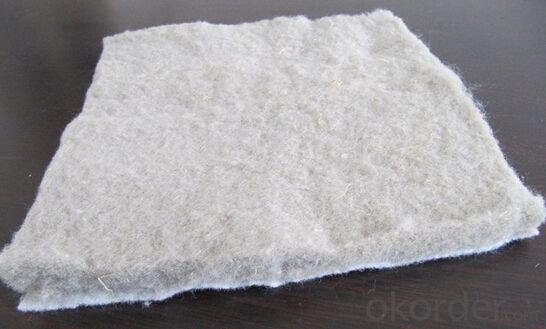

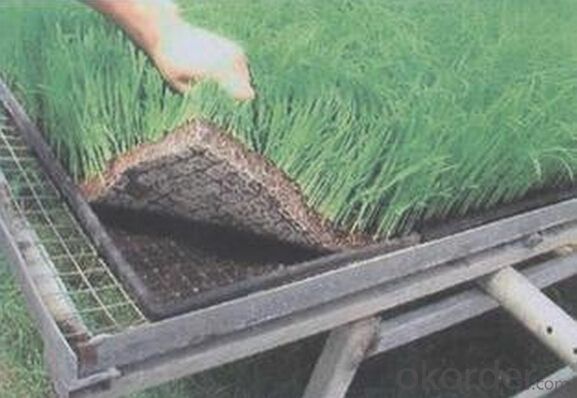

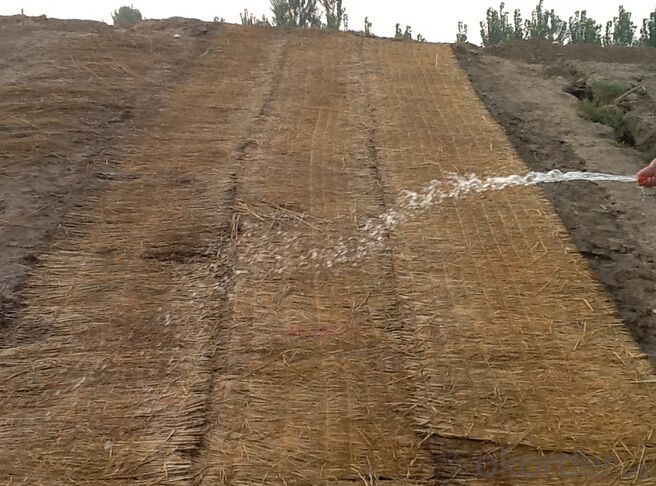
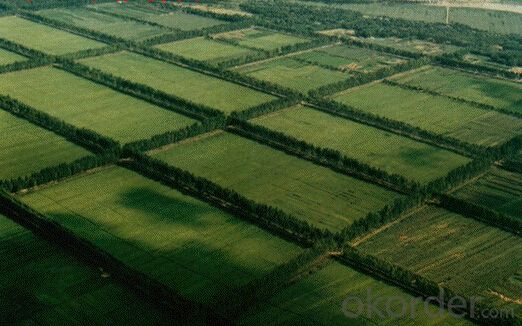
- Q:What are the specifications for geotextiles in erosion control projects?
- The specifications for geotextiles in erosion control projects typically include factors such as tensile strength, permeability, thickness, and specific weight. They should be able to withstand the forces of soil erosion, have a suitable permeability to allow water to pass through while retaining the soil, and be of a thickness and weight that can effectively support the intended application.
- Q:Can geotextiles be used for drainage?
- Yes, geotextiles can be used for drainage. They are commonly used in various drainage applications such as road construction, retaining walls, and landfills. Geotextiles help in preventing soil erosion, filtering out sediments, and allowing water to pass through while retaining the soil.
- Q:How do geotextiles help with soil reinforcement in soft ground conditions?
- Geotextiles help with soil reinforcement in soft ground conditions by providing a stable and strong layer that distributes the load more evenly. They act as a barrier and prevent the intermixing of different soil layers, improving the overall stability and strength of the ground. Additionally, geotextiles can help with drainage by allowing water to pass through while retaining the soil particles, preventing erosion and maintaining the integrity of the ground.
- Q:How are geotextiles used in retaining walls?
- Geotextiles are commonly used in retaining walls to reinforce the soil and prevent erosion. They are placed between the backfill soil and the wall, acting as a barrier to separate the soil layers and improve stability. This helps to distribute the soil pressure evenly, reducing the risk of wall failure and improving the overall strength and longevity of the retaining wall structure.
- Q:Stone cage slope is the first gravel or the first shop geotextile
- Hello, the first shop geotextile, put the cage on top, into the stone seal can be. We are Dongrun stone cage factory hope to help you.
- Q:Can geotextiles be used for reinforcement of bridge abutments?
- Yes, geotextiles can be used for the reinforcement of bridge abutments. Geotextiles are commonly used in civil engineering applications for their ability to provide stability, filtration, and separation. When placed correctly, geotextiles can enhance the strength and durability of bridge abutments by distributing load, preventing soil erosion, and improving overall stability.
- Q:Can geotextiles be used in agricultural waste management systems?
- Yes, geotextiles can be used in agricultural waste management systems. They are often used for soil stabilization, erosion control, and filtration in agricultural applications, including waste management systems. Geotextiles can help to prevent soil erosion, filter out pollutants, and promote water drainage in these systems, making them an effective solution for managing agricultural waste.
- Q:What are the specifications for geotextiles used in erosion control mats?
- The specifications for geotextiles used in erosion control mats typically include properties such as high tensile strength, durability, UV resistance, and permeability to water. These geotextiles are often made from synthetic materials like polypropylene or polyester, with specific weight and thickness requirements to ensure effective erosion control. Additionally, they may need to meet certain industry standards or certifications for quality assurance.
- Q:What are the cost implications of using geotextiles?
- The cost implications of using geotextiles can vary depending on several factors. Initially, geotextiles may have a higher upfront cost compared to traditional materials. However, they can provide long-term cost savings by extending the lifespan of infrastructure and reducing maintenance requirements. Geotextiles can also minimize the need for expensive excavation and replacement of poor soil, resulting in overall cost reductions. Additionally, the use of geotextiles can enhance construction efficiency, reducing labor costs and project timelines. Therefore, while there may be initial investment, the long-term cost implications of using geotextiles can be beneficial.
- Q:Can geotextiles be used in geogrid reinforced soil walls?
- Yes, geotextiles can be used in geogrid reinforced soil walls. Geotextiles are often used as a separation and filtration layer between the soil and the geogrids in order to prevent soil migration and maintain the integrity of the reinforced wall structure.
1. Manufacturer Overview |
|
|---|---|
| Location | |
| Year Established | |
| Annual Output Value | |
| Main Markets | |
| Company Certifications | |
2. Manufacturer Certificates |
|
|---|---|
| a) Certification Name | |
| Range | |
| Reference | |
| Validity Period | |
3. Manufacturer Capability |
|
|---|---|
| a)Trade Capacity | |
| Nearest Port | |
| Export Percentage | |
| No.of Employees in Trade Department | |
| Language Spoken: | |
| b)Factory Information | |
| Factory Size: | |
| No. of Production Lines | |
| Contract Manufacturing | |
| Product Price Range | |
Send your message to us
Non-Woven Polyester and Polypropylene Nutrition Geotextile
- Loading Port:
- Qingdao
- Payment Terms:
- TT OR LC
- Min Order Qty:
- 5000 m²
- Supply Capability:
- 2000000 m²/month
OKorder Service Pledge
OKorder Financial Service
Similar products
New products
Hot products
Related keywords
